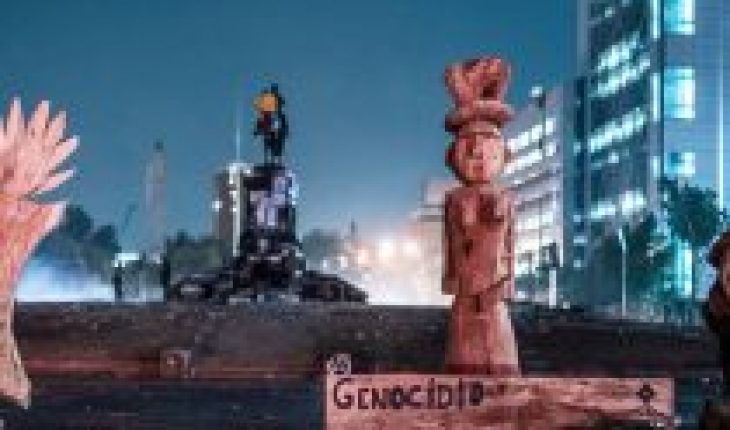Two years after October 18, ready to begin writing the constitutional text that will mark our life together, the desires around the new Magna Carta become more explicit. Desires of the conventional, as of a large part of the citizenry, whose hands must be intertwined to elaborate a constitution that responds effectively to the needs and urgencies expressed in different ways for decades. Longings expressed with an unexpected force in what was “the revolt”, “the outbreak” and “the awakening of Chile”, which finally opened the possibility of the moment in which we find ourselves.
The word that must be imprinted in this new fundamental charter must then give an account of those desires and challenges of the twenty-first century through which we are transiting. It will initially be a palimpsest, with multiple possible names since it will be the bearer of every great desire: the constitution of Dignity, the Feminist Constitution, the Plurinational Constitution, the Decolonial Constitution, the Eco-environmental Constitution, and we also want it to be the Cultural Constitution.
There are undoubtedly many perspectives that this new political text must contain, and all of them are complementary. Thus, the initial palimpsest will be adjusted until a harmonious and coherent text is chained, which gives full and substantive guarantees of dignity, equality, justice, freedom, participation, among others. When we say that we want this to be also a Cultural Constitution, we say that the culture and diversity of our cultural expressions must be considered transversally throughout the constitutional text, closely associated with each of the pillars that will sustain its architecture itself.
As Amaya Álvez points out, in the book “The Feminist Constitution”, the constitution is in itself a cultural construction, which “establishes the rules of coexistence of political society and distributes power through the catalog of fundamental rights”, but, in turn, must explicitly incorporate the cultural rights enshrined in declarations, pacts and international conventions. This is an inescapable factor in rebuilding senses of community.
In a broad sense, cultural rights are those human rights recognized in international instruments that are related to culture. As Donders (2011) argues, they are those rights that play an important role in the preservation and development of culture, although today it is difficult to ignore that all rights have a cultural dimension, such as the right to housing, the right to freedom of expression or the right to organize, understood as an expression of the way of living and organizing together (Álvarez & Correa, 2016).
And it is not only a question of access to cultural goods, in the logic that some are the creators and the others, audiences, cultural consumers, terminology that has naturalized neoliberalism in the cultural field, and that has shaped commodified relations. As the Universal Declaration of Human Rights puts it, “everyone has the right to take part freely in the cultural life of the community”, favoring a much more active conception in relation to culture, as citizens and cultural citizens.
This is clearly highlighted by General Comment 21 of the Committee on Economic, Social and Cultural Rights of the United Nations when it points out that participation, access and contribution to cultural life are interrelated elements, fostering a society where we are all effectively cultural builders, critical subjects, capable of reading and understanding what surrounds us, with a view of the world in which we live.
Both the United Nations International Covenant on Economic, Social and Cultural Rights of 1966 and the 2005 UNESCO Convention on the Protection and Promotion of the Diversity of Cultural Expressions reinforce the radical importance of incorporating the cultural dimension in order to move towards a fuller society and a dignified life. And obviously it is not a question of putting the word “culture” as an ornament, limiting its presence to a formal expression.
How to get it to have a substantive presence?
Without prejudice to the limited international debate and the almost zero national debate on cultural rights, we believe it is necessary that the constitutional discussion consider the recommendations contained in the Freiburg Declaration on Cultural Rights, which recognize the following six areas or categories of rights that can materialize the concept of derec.cultural hos:
(i) Right to identity and cultural heritage. Everyone is recognized as the individual or collective right to choose and to have their cultural identity respected; to know and respect their own culture, as well as the cultures which, in their diversity, constitute the common heritage of humanity; and the right to access cultural heritages that constitute expressions of different cultures.
(ii) Right to cultural self-determination. Everyone has the right to exhibit or not to exhibit a link with a cultural community, that is, to identify or not with one or more cultural communities;
(iii) The right of access to and participation in the cultural life of everyone, freely and without restriction, including, on the one hand, the exercise of freedom of expression in the language of one’s choice and the freedom to exercise one’s own cultural practices and, on the other, the freedom to share knowledge and cultural expressions; enjoying the protection of the moral and patrimonial interests derived from their creations.
(iv) Right to education and training. The right of everyone to education and training that contribute to the free and full development of their cultural identity is recognized, provided that the rights of others and cultural diversity are respected;
v) Right to information and communication. As part of the right to freedom of expression, everyone has the right to receive free and pluralistic information that contributes to the full free and complete development of their cultural identity;
(vi) Right to cultural cooperation. Everyone has the right to participate in the cultural development of the communities to which he belongs; in the elaboration, implementation and evaluation of decisions concerning them and affecting the exercise of their cultural rights; and in cultural development and cooperation.
In addition to them, it would be good to consider that, in each area and chapter of the constitutional text, it would be necessary to consider the character and cultural implication of it, in understanding that culture is understood as the ways of living, the ways of relating, the value systems, the traditions and the beliefs that can share a society or group of individuals determines, as noted in United Nations General Comment 21.
For a dignified, more just, human Chile, with nature, and not above nature, to effectively sprout from the constituent process we are experiencing, which makes possible a “good life”, a profound cultural change is required. That is why it is so important an explicit presence -transversal and specific- of culture and cultural rights in the new Magna Carta, that they signify each part of it in its cultural dimension.
Daniel Álvarez Valenzuela is an academic at the Faculty of Law of the University of Chile. Paulo Slachevsky Chonchol is editor of LOM Ediciones and member of Editores de Chile.
For a Cultural Constitution – El Mostrador
October 25, 2021 |





